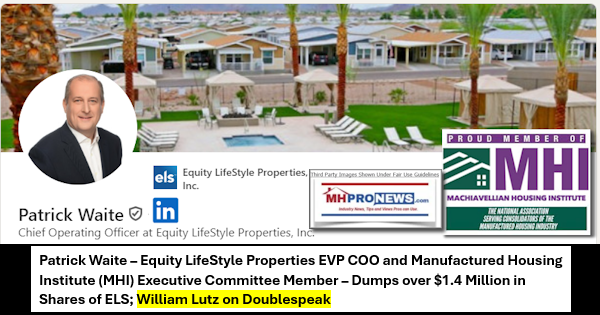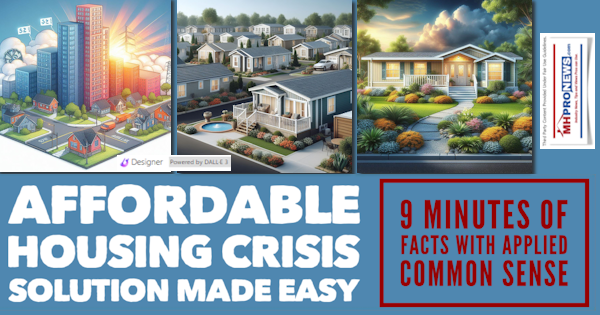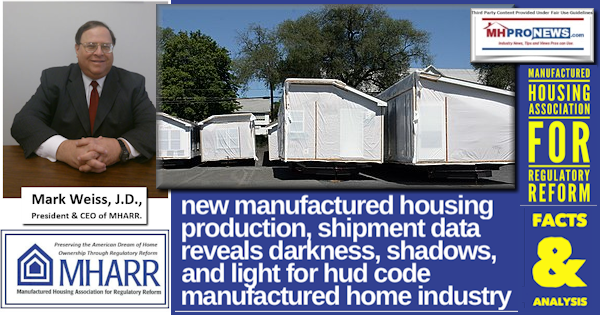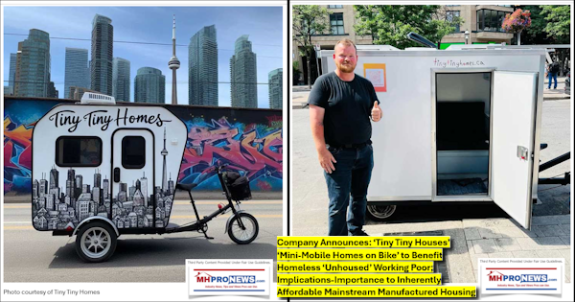Some time ago, the Manufactured Housing Institute (MHI) quietly stopped publishing what for years was their version of this report. It was a data point that they suspended, apparently due to the embarrassing failure of Clayton and Big 3 MHI producers backed CrossModTM homes to increase production. Thankfully, the Manufactured Housing Association for Regulatory Reform (MHARR) has continued this informative service. For a variety of reasons, MHProNews has not published this report and analysis until now. That commentary will continue following their HUD-paid-for data.

FOR IMMEDIATE RELEASE Contact: MHARR
(202) 783-4087
HUD CODE PRODUCTION INCREASES IN AUGUST 2021
Washington, D.C., October 4, 2021 – The Manufactured Housing Association for Regulatory Reform (MHARR) reports that according to official statistics compiled on behalf of the U.S. Department of Housing and Urban Development (HUD), HUD Code manufactured housing industry year-over-year production increased once again in August 2021. Just-released statistics indicate that HUD Code manufacturers produced 9,087 homes in August 2021, a 14.5% increase over the 7,933 new HUD Code homes produced during August 2020. Cumulative production for 2021 now totals 70,410 homes, a 14.3% increase over the 61,583 homes produced during the same period in 2020.
A further analysis of the official industry statistics shows that the top ten shipment states from the beginning of the industry production rebound in August 2011 through August 2021 — with cumulative, monthly, current year (2021) and prior year (2020) shipments per category as indicated — are:

The August 2021 production data moves Michigan ahead of California in the cumulative top-ten list, based now on 10-years of production information.
The Manufactured Housing Association for Regulatory Reform is a Washington, D.C.-based national trade association representing the views and interests of independent producers of federally-regulated manufactured housing.
— 30 –
Despite the apparent loss of a congressional seat as a result of the 2020 Census, California is still the most populous state in the nation. California’s rate of homeownership is significantly below that of the U.S. average. While the rate of homeownership in California, per the St. Louis Federal Reserve data shown below, rose overall during the Trump Administration, it was already lower than the U.S. in general.
Homeownership Rate for California (CAHOWN) Download
| 2020: | 55.9 |
| 2019: | 54.8 |
| 2018: | 55.1 |
| 2017: | 54.4 |
| 2016: | 53.8 |
According to the U.S. Census Bureau on 7.27.2021: “The homeownership rate of 65.4 percent was 2.5 percentage points lower than the rate in the second quarter 2020 (67.9 percent) and not statistically different from the rate in the first quarter 2021 (65.6 percent).” So, per those data points, CA lags the U.S. by some 9.5 percent.
Some other data points are useful. This per GSE Fannie on 7.24.2021.
“Fannie Mae expects multifamily starts (2+ units per building) to be 460,000 units in 2021, up 16,000 units from the level forecast in July. The forecasts for multifamily starts in 2022 was revised upward by 9,000 units to 406,000 units.” That would be about 4 times the rate of manufactured home production and sales.
Per Trading Economics on 9.21.2021:
 Housing starts in the US were up 3.9% to a seasonally adjusted annual rate of 1.615 million units in August of 2021, rebounding from a downwardly revised 6.2% fall in July and beating market forecasts of 1.554 million. Starts of buildings with five units or more jumped 21.6% to 530,000 while the single-family segment dropped 2.8% to 1,076,000. Starts surged the most in the Northeast (167.2% to the highest level since January), the Midwest (11.4%) and the South (1.4%) but fell in the West (-21.1%).
Housing starts in the US were up 3.9% to a seasonally adjusted annual rate of 1.615 million units in August of 2021, rebounding from a downwardly revised 6.2% fall in July and beating market forecasts of 1.554 million. Starts of buildings with five units or more jumped 21.6% to 530,000 while the single-family segment dropped 2.8% to 1,076,000. Starts surged the most in the Northeast (167.2% to the highest level since January), the Midwest (11.4%) and the South (1.4%) but fell in the West (-21.1%).
Then consider this data point. “After years of relatively weak residential construction, the median age of the US housing stock increased sharply from 34 years in 2007 to 41 years in 2019,” according to the Joint Center for Housing Studies at Harvard (JCHS) “The State of the Nation’s Housing 2021.” That study, as was previously reported by MHProNews, barely mentioned manufactured housing at all. That stands in stark contrast to former JCHS fellow Eric Belsky, who was once touted by MHI for his projection that manufactured homes would surpass conventional housing by 2010. Belsky made that projection knowing that manufactured housing had slumped. He fully expected the industry to recover.
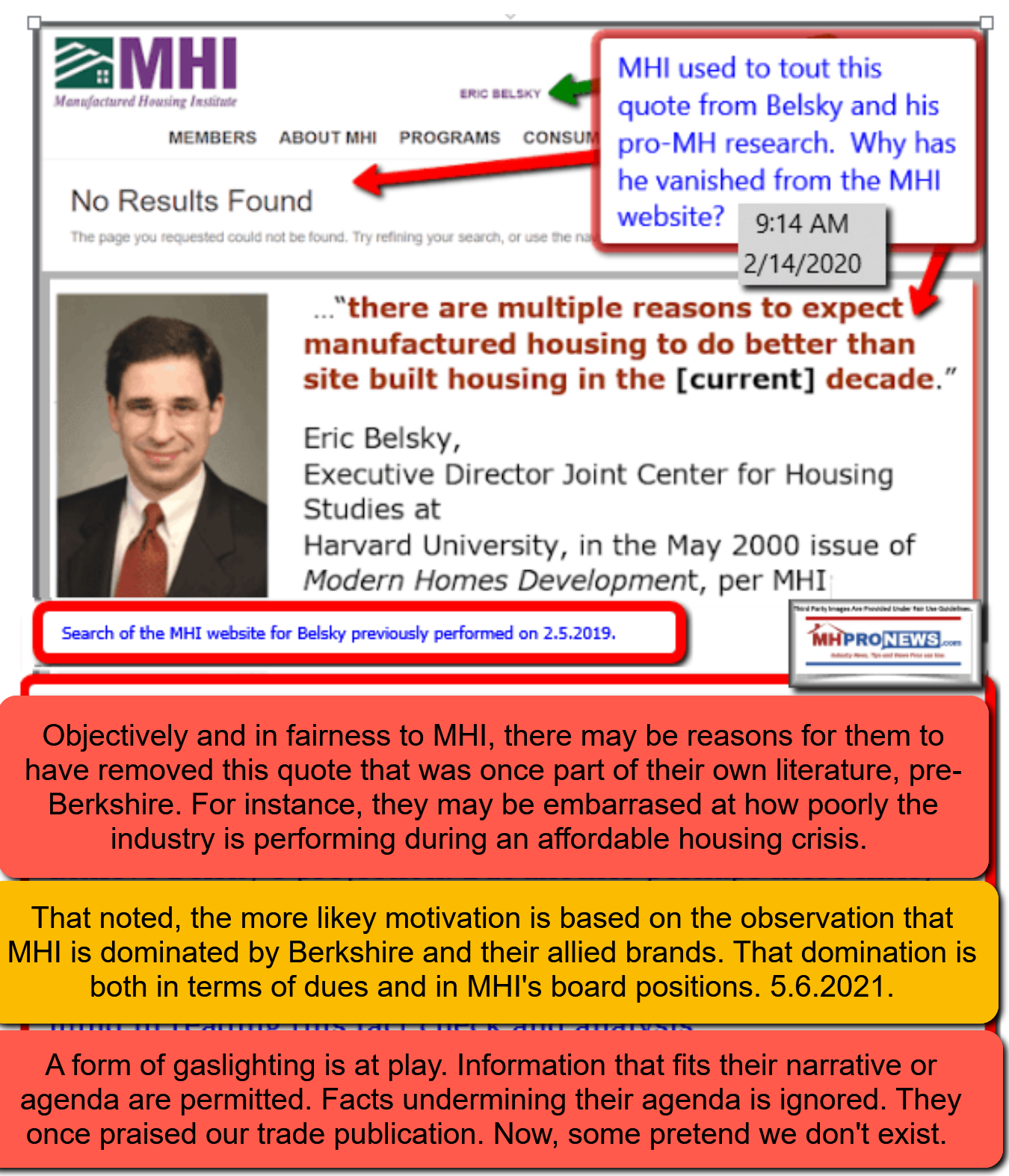
Clearly, Belsky was wrong. Which begs the question, what happened that caused that error in projection? One must look to sources such as MHARR, MHBA, Doug Ryan/CFED-turned Prosperity Now, CFPB, the SEC suit against Cavco, James A. Schmitz Jr. and his fellow Minneapolis Fed and other researchers, and Samuel Strommen at Knudson Law for answers.


As our report for Sunday revealed, much of these facts, concerns, and evidence-based allegations of corruption are entirely ignored by others in our profession’s trade media and bloggers.
No Title
No Description
What the data reveals is quite the opposite of what MHI defenders, surrogates, or “The Institute” themselves have claimed over the years. Does MHI “Got Clout?” Perhaps. But if so, perhaps the better question is, how has the MHI clout been used? Has their “clout” helped or harmed manufactured housing?
The surge in sales is despite MHI efforts, not because of them. A well-placed source within MHI previously told MHProNews to expect a downturn. It came to pass.


But that same MHI-connected source believes that the industry is heading for yet another downturn. The reason? Because the core, underlying issues of the industry have yet to be properly addressed. These are hardly secret. As would-be MHI defender, and claimed Florida manufactured housing promoter Jim Ayotte said, “This is Not Rocket Science.” Quite so. The plan should be P.E.P. Protect, Educate, Promote. But at each turn, what MHI claims to do is not being done.
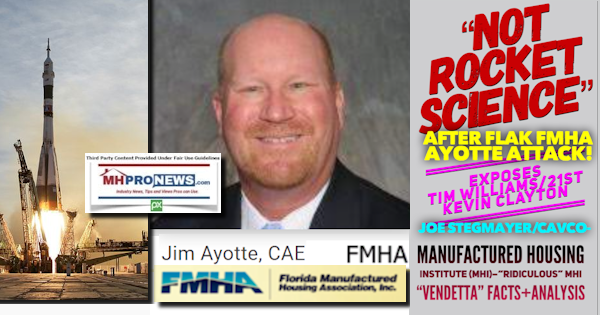
MHARR is a producers association. Advocacy on behalf of independent producers is their core mission. The only reason, say sources at MHARR, that they are engaged at all on post-production problems is because MHI is quite apparently not doing their job.


As Mark Weiss, sarcastically began in an Issues and Perspectives, the drag of MHI on their own affiliates seems clear too.
 Well, the good news is that the debilitating zoning problem faced by the HUD Code manufactured housing industry and its consumers has apparently evaporated into thin air. That’s right. On May 15, 2019, MHARR invited state manufactured housing associations around the country to provide it with particularly egregious, actionable cases of zoning and/or placement discrimination by localities against federally-regulated manufactured homes. MHARR sought information on cases involving the discriminatory exclusion of both manufactured home communities and individual home placements (one each, from each state) that could be vetted and, if necessary, litigated – by MHARR, or with MHARR support, as appropriate – to seek and obtain favorable precedents that could then be asserted in other jurisdictions: (1) to stem the tide of baseless restrictions on the placement of manufactured homes (absent a more aggressive assertion of broad federal preemption by HUD, which MHARR has been seeking for years); and (2) to expand the availability of modern, affordable manufactured homes in accordance with the Manufactured Housing Improvement Act of 2000. Given the reports that seem to emerge almost daily concerning local jurisdictions imposing outright or partial bans on the placement of manufactured homes, combined with the nearly year-long downturn in manufactured housing sales volume, one would have expected a robust response to this offer of no-strings assistance and support. Instead, the response – for the most part — has been silence.
Well, the good news is that the debilitating zoning problem faced by the HUD Code manufactured housing industry and its consumers has apparently evaporated into thin air. That’s right. On May 15, 2019, MHARR invited state manufactured housing associations around the country to provide it with particularly egregious, actionable cases of zoning and/or placement discrimination by localities against federally-regulated manufactured homes. MHARR sought information on cases involving the discriminatory exclusion of both manufactured home communities and individual home placements (one each, from each state) that could be vetted and, if necessary, litigated – by MHARR, or with MHARR support, as appropriate – to seek and obtain favorable precedents that could then be asserted in other jurisdictions: (1) to stem the tide of baseless restrictions on the placement of manufactured homes (absent a more aggressive assertion of broad federal preemption by HUD, which MHARR has been seeking for years); and (2) to expand the availability of modern, affordable manufactured homes in accordance with the Manufactured Housing Improvement Act of 2000. Given the reports that seem to emerge almost daily concerning local jurisdictions imposing outright or partial bans on the placement of manufactured homes, combined with the nearly year-long downturn in manufactured housing sales volume, one would have expected a robust response to this offer of no-strings assistance and support. Instead, the response – for the most part — has been silence.
As an aside, it’s worth noting that lying at the root of the industry’s major post-production problems relating to exclusionary and/or discriminatory zoning and placement restrictions, and the discriminatory treatment of manufactured housing consumer personal property loans – despite the existence of good laws addressing the implementation of both – is the absence of a truly independent, national, collective, post-production trade organization. As MHARR has previously emphasized, it is the absence of such an organization, focused on effectively addressing specific and quite serious problems affecting the post-production sector – for the ultimate benefit of the entire industry and manufactured housing consumers – which has allowed those problems to fester and grow steadily worse.”
“THE INCREDIBLE SHRINKING ZONING PROBLEM.”-SEPTEMBER 2019 MHARR ISSUES AND PERSPECTIVES | Manufactured Housing Association for Regulatory Reform
MHARR invited state manufactured housing associations to provide with particularly egregious, actionable cases of zoning and/or placement discrimination…
That was 9.18.2019. What MHARR offered to do, is what MHI is supposed to be doing, IF they meant what they claim. But there are evidence-based reasons to doubt what comes out of their spouts.



MHProNews noted years ago, while Rick Robinson was MHI’s general counsel, that the Arlington, VA based MHI had as their in house attorney a man that literally wrote a book about Writ of Mandamus. It is simply not possible to make this stuff up, but nor is there a reason to do so. Reality, be it dark, or the shadows that emerge when light is provided, is what is needed to explain why there is such a low rate of manufactured home production during an affordable housing crisis.
“Mandamus is a judicial remedy in the form of an order from a court to any government, subordinate court, corporation, or public authority, to do some specific act which that body is obliged under law to do, and which is in the nature of public duty, and in certain cases one of a statutory duty,” said Wikipedia.
When MHI fails to do what they obviously should be doing, it raises questions of competence and corruption.
MHI and their surrogates cannot have it both ways. They can’t claim “clout,” and then fail to deliver the results that clout should yield.
This ongoing series of fact-checks and analysis is not merely moaning and groaning. There is, and has been, a need to establish a baseline of facts. Of necessity, there has been a necessary and systematic publication of prima facie, unambiguous and definitive evidence that MHI claims one thing, but obviously fails to perform.
That MHI is acting on behalf of dominating members is obvious. Given repeated opportunities to their leaders and attorneys to debate these claims, they have instead stood silent. That means that the evidence is essentially unchallenged, and what challenges have been attempted by surrogates have easily been publicly batted aside. Those surrogates have not stepped up for another helping of that factual and evidence-based medicine.
But back to the point. If it was garden variety incompetence ruling at MHI, one would expect their board members to step in. But that has not occurred. That is at least implied evidence that they like what they are getting. Indeed, statements by some of their corporate leaders make that clear.
Those corporate leaders are rejoicing over consolidation, or “mergers and acquisitions” This has now been well documented.

All of those MHI photo and video opportunities in recent years proves they have access. As the Biden-Harris campaign website made clear, access is a form of currency in Washington, D.C. Given that MHI has documented their access, how have they used that currency?


Again, the answer is increasingly clear. They have joined in several cases with the competitors of manufactured housing, instead of fighting for manufactured home producers, sellers, communities, and other professional interests.
There is a range of evidence that demonstrates that manufactured housing has dramatically consolidated. That consolidation could be dated from the start of the Berkshire Hathaway era of the industry, circa 2002-2003. Consolidation and the loss of thousands of independent retailers, and “over” 160 plants accelerated following the notorious Tim Williams/21st Mortgage Corporation letter.
All of that and more is unpacked by Sam Strommen’s seminal third-party research.

With the foundation of evidence now well established, the challenges to that having been publicly addressed, the next steps can proceed. Step one of several is linked below.
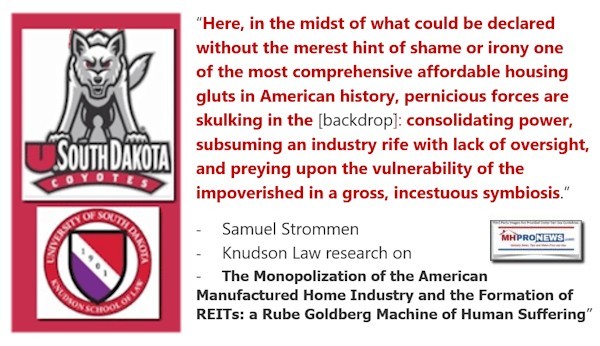
For the subsequent steps, stay tuned. God willing, the best is yet to come. But it will not happen without effort.
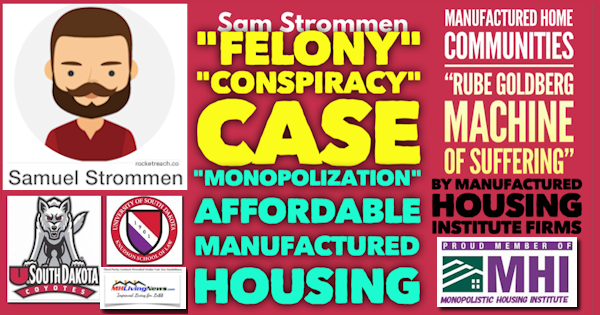
In a recruitment ad for the military, on 2.202.2013 there was this. Voiceover: “Even though there are 1,045,690 soldiers like me, I am my own force. . . . The might of the U.S. Army doesn’t lie in numbers. It lies in me. I am an Army of One.”
That may have been inspired at some level by this: “One man with courage is a majority.” Thomas Jefferson.
The forces of darkness in our profession may have in several respects ‘an upper hand.’ But when someone breaks the law, that makes them vulnerable.
There is now an evidence based foundation that reveals that they are legally vulnerable. MHI and state association board members cannot claim ignorance, because there is clear evidence that they are reading these items.
MHI corporate board members also have an obligation to their shareholders.
Tick tock, tick tock. The durable competitive advantage may just be Godly truth, the inspiration to resist for just causes, and in enforcing existing laws. Warren, you and your allies in MHVille’s “moats” may have sprung a leak, and you just didn’t notice. Stay tuned. ##
##


###



[cp_popup display=”inline” style_id=”139941″ step_id = “1”][/cp_popup]
Stay tuned for more of what is ‘behind the curtains’ as well as what is obvious and in your face reporting that are not found anywhere else in MHVille. It is all here, which may explain why this is the runaway largest and most-read source for authentic manufactured home “News through the lens of manufactured homes and factory-built housing” © where “We Provide, You Decide.” © ## (Affordable housing, manufactured homes, reports, fact-checks, analysis, and commentary. Third-party images or content are provided under fair use guidelines for media.) (See Related Reports, further below. Text/image boxes often are hot-linked to other reports that can be access by clicking on them.)

By L.A. “Tony” Kovach – for MHProNews.com.
Tony earned a journalism scholarship and earned numerous awards in history and in manufactured housing.
For example, he earned the prestigious Lottinville Award in history from the University of Oklahoma, where he studied history and business management. He’s a managing member and co-founder of LifeStyle Factory Homes, LLC, the parent company to MHProNews, and MHLivingNews.com.
This article reflects the LLC’s and/or the writer’s position, and may or may not reflect the views of sponsors or supporters.
Connect on LinkedIn: http://www.linkedin.com/in/latonykovach
Related References:
The text/image boxes below are linked to other reports, which can be accessed by clicking on them.













